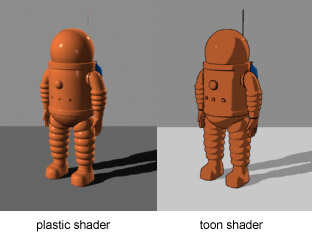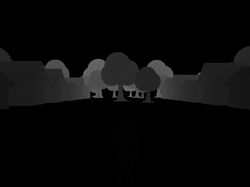Cel-shaded animation
From Wikipedia, the free encyclopedia
| This article does not cite any references or sources. Please help improve this article by adding citations to reliable sources (ideally, using inline citations). Unsourced material may be challenged and removed. (March 2009) |
Cel-shaded animation (also called cel-shading or toon shading) is a type of non-photorealistic rendering designed to make computer graphics appear to be hand-drawn. Cel-shading is often used to mimic the style of a comic book or cartoon. It is a somewhat recent addition to computer graphics, most commonly turning up in console video games. Though the end result of cel-shading has a very simplistic feel like that of hand-drawn animation, the process is complex. The name comes from the clear sheets of acetate, called cels, that are painted on for use in traditional 2D animation, such as Disney classics.[1]
Contents |
[edit] Process
The cel-shading process starts with a typical 3D model. Where cel-shading differs from conventional rendering is in its use of non-photorealistic lighting. Conventional (smooth) lighting values are calculated for each pixel and then mapped to a small number of discrete shades to create the characteristic flat look – where the shadows and highlights appear more like blocks of color rather than mixed in a smooth way.
Black "ink" outlines and contour lines can be created using a variety of methods. One popular method is to first render a black outline, slightly larger than the object itself. Backface culling is inverted and the back-facing triangles are drawn in black. To dilate the silhouette, these back-faces may be drawn in wireframe multiple times with slight changes in translation. Alternately, back-faces may be rendered solid-filled, with their vertices translated along their vertex normals in a vertex shader. After drawing the outline, back-face culling is set back to normal to draw the shading and optional textures of the object. Finally, the image is composited via Z-buffering, as the back-faces always lie deeper in the scene than the front-faces. The result is that the object is drawn with a black outline and interior contour lines. Popularly, this "ink" outline applied to animation and games is what’s called cel-shade, while originally the term refer to the shading technique, indifferent if the outline is being applied or not.
The Utah teapot rendered using cel-shading:
- The back faces are drawn with thick lines
- The object is drawn with a basic texture
- Shading
Steps 2 and 3 can be combined using multi-texturing (see texture mapping).
Another outlining technique is to use 2D image-processing. First, the scene is rendered (with cel-shading) to a screen-sized color texture:
Then, the scene's depth and world-space surface normal information are rendered to screen-sized textures:
A Sobel filter or similar edge-detection filter is applied to the normal/depth textures to generate an edge texture. Texels on detected edges are black, while all other texels are white:
Finally, the edge texture and the color texture are composited to produce the final rendered image:
As with most image-processing techniques, the performance penalty for this method is not affected by scene complexity.
[edit] History
[edit] Video games
The first 3D video game to feature true real-time cel-shading was Jet Set Radio (2000) for the Sega Dreamcast. Another game, Fear Effect for the Sony PlayStation, was released in 2000 and was noted for its use of dramatic textures to give an anime appearance to its characters, but lacked outlines and dynamic light-sourcing. Games before Fear Effect have used textures in a similar fashion, but not as starkly apparent or stylized as the game. Wacky Races, released on Dreamcast a few months before Jet Set Radio, featured an outline effect often mistaken for cel-shading, but the game actually used traditional shading techniques. There are several other games, such as Mega Man Legends, that used static textures with high contrast separation of color in the same vein as Fear Effect created before the previous examples, but the effect created was not actual cel shading, as it produced no outline effect nor any actual shading.
In the years following Jet Set Radio, numerous other cel-shaded games were introduced during a minor fad involving cel-shaded graphics, yet only a few would fully match or surpass its mainstream appeal. The next games with cel-shading to capture the industry's attention in some form were 2002's Jet Set Radio Future and Sly Cooper and the Thievius Raccoonus. Over time, more cel-shaded titles such as Dark Chronicle, Cel Damage, Klonoa 2: Lunatea's Veil, the Viewtiful Joe series, and XIII were released with positive feedback, though none were considered blockbusters in terms of sales figures. Originally the only cel-shaded games to receive both positive ratings and sales after Sly Cooper and the Thievius Raccoonus were The Legend of Zelda: The Wind Waker, Sly 2: Band of Thieves, and Tales of Symphonia.
Originally, The House of the Dead III (HotD3) for the Microsoft Xbox was cel-shaded. Early in HotD3's development Sega released screenshots of the then current cel-shaded graphics to the gaming community. Shortly after those initial screenshots were released, Sega announced that they were dropping the cel-shaded graphics in favor of conventional graphic techniques. There are several suspected reasons for Sega's change of heart, the most popular and most likely is that the screenshots met much negative response from gamers who disliked the cel-shaded graphical style. Many gamers claimed the cel-shading was used purely as a gimmick in an attempt to sell more games. HotD3 was a bloody, gory and very violent light gun game which featured zombies and other mutated and deformed creatures. Many felt the cel-shaded look clashed greatly with the game's themes and content.
More recently, handheld consoles, previously not realistically powerful enough to render a fully 3D world, have made use of cel-shading. Most notable is the Tony Hawk series and The Legend of Zelda: Phantom Hourglass on the Nintendo DS.
The use of cel-shading in video games has somewhat slowed since its inception, even though the technique has been used in recent acclaimed titles. Examples include Dragon Quest VIII, Rogue Galaxy, Killer 7, No More Heroes, Metal Gear Acid 2, Ōkami and Prince of Persia (2008); although, should be noticed, that some of these titles only use the outline effect and do not apply the shading technique that creates the flat look.
[edit] List of cel-shaded media
[edit] Video games
[edit] Film and television
- Appleseed
- Armitage Dual-Matrix
- Atomic Betty
- Avatar: The Last Airbender
- Bakugan Battle Brawlers
- Ben 10: Secret of the Omnitrix
- Canada's Worst Driver
- Class of the Titans
- Daily Planet (2005-2006 season)
- Delilah and Julius
- D.I.C.E.
- Digimon Savers
- Dinosaur King
- Doctor Who: The Infinite Quest
- Dragon Booster
- Drinky Crow
- Duck Dodgers
- Fairly OddParents
- Family Guy
- Fantastic Four: World's Greatest Heroes
- Ferngully: The Last Rainforest
- Freedom Project
- Funky Cops
- Fullmetal Alchemist the Movie: Conqueror of Shamballa
- Futurama
- Galactik Football
- Ghost in the Shell: Stand Alone Complex
- Ghost in the Shell: S.A.C. 2nd GIG
- G.I. Joe: Sigma 6
- Handy Manny
- He-Man and the Masters of the Universe
- Hey Arnold!: The Movie
- Hot Wheels Highway 35 World Race
- Idaten Jump
- Initial D: 4th Stage
- Invader Zim
- Justice League
- Kakurenbo: Hide & Seek
- Kappa Mikey
- Kim Possible
- Kirby: Right Back at Ya!
- Legion of Super Heroes
- Lego Exo-Force
- Loonatics Unleashed
- Macross Frontier
- MegaMan NT Warrior
- Mobile Suit Gundam 00
- Mobile Suit Gundam SEED
- Mobile Suit Gundam SEED Destiny
- Monster House
- Ōban Star-Racers
- One Piece
- Osmosis Jones
- Paprika
- Pokemon Battle Frontier (Nosepass)
- Pokémon: Destiny Deoxys
- Pokémon Diamond and Pearl (Combee)
- Pokémon: Jirachi Wishmaker
- Renaissance
- Rugrats Go Wild
- Silver Surfer
- Skyland
- Sonic X
- Speed Racer: The Next Generation
- Spider-Man
- Starchaser: The Legend of Orin
- Star Wars: Clone Wars
- Steamboy
- Storm Hawks
- Stuart Little 3: Call of the Wild
- Superior Defender Gundam Force
- Superman: Doomsday
- Team Galaxy
- The Iron Giant
- The Littlest Robo
- The Simpsons (season 19+)
- The Simpsons Movie
- Titan A.E.
- Tom and Jerry: Blast Off to Mars
- Tom and Jerry: The Fast and the Furry
- Transformers Cybertron
- Transformers Energon
- Treasure Planet
- Vexille
- Winx Club
- Zoids
[edit] Commercials
- 2008 Scion xD Little Deviants
- 2009 Dodge Journey
- Boogie
- BP Connect 2007 ad's
- AREVA
- Blockbuster Total Access
- Commit mint lozenges
- Cartoon Network Master Control
- HSBC HSBCdirect.com
- Hewlett Packard xw8400 Workstation Titans of iron
- Mr. Clean
- Pampers Kandoo Flushable Toilet Wipes, Foaming Handsoap
- Post Cereals Fruity Pebbles cereal (Bowling for Fruity Pebbles ad)
- Lego Exo-Force
- L'Oréal Couleur Expert
- Lunchables Pizza (Atlantis Paradise Island promotion ad)
- McCain's Zwak Punch
- Neopets virtual prize code (Canadian Betty Crocker fruit-flavored snacks promotional ad)
- Oscar Mayer Lunchables Chicken Dunks (airhead mysteries ad)
- Sola/Nero/Vena/Olera/Zonte sparkling wine
- Toyo Tires Versado LX all-season touring tires (OK Tire promotional ad)
[edit] Similar technology
Interpolated rotoscoping can be used to create a similar effect, but the source material does not need to be computer generated. In addition, rotoscoping is applied to an existing image, whereas cel-shading is applied during the generation of the image.
[edit] See also
- Traditional animation
- Special effects animation
- Character animation
- Computer animation and 3D computer graphics
- Skeletal animation
- Non-photorealistic rendering
[edit] References
- CelShading.com. More information on 3D cel-shading including an image gallery.
- Celshader.com FAQ. Retrieved August 2, 2005.
- IGN: Jet Set Radio Review. Retrieved August 4, 2005.
- GameDev.net - Cel-Shading. Retrieved August 5, 2005.








